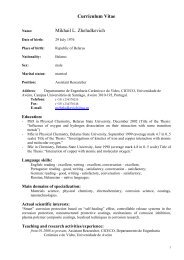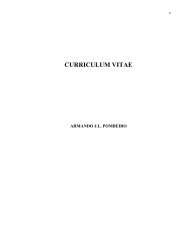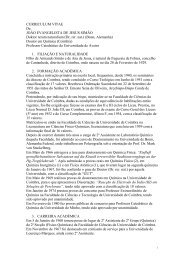XII Iberian Meeting of Electrochemistry XVI Meeting of the ...
XII Iberian Meeting of Electrochemistry XVI Meeting of the ...
XII Iberian Meeting of Electrochemistry XVI Meeting of the ...
Create successful ePaper yourself
Turn your PDF publications into a flip-book with our unique Google optimized e-Paper software.
<strong>XII</strong> <strong>Iberian</strong> <strong>Meeting</strong> <strong>of</strong> <strong>Electrochemistry</strong> & <strong>XVI</strong> <strong>Meeting</strong> <strong>of</strong> <strong>the</strong> Portuguese Electrochemical Society PE 07<br />
Electrochemical behaviour <strong>of</strong> novel scorpionate and pyrazole<br />
dioxovanadium complexes<br />
Telma F.S. Silva, 1 Konstantin V. Luzyanin, 1 Luísa M.D.R.S. Martins, 1,2<br />
Armando J.L. Pombeiro 1<br />
1 Centro de Química Estrutural, Complexo I, Instituto Superior Técnico, Av. Rovisco Pais, 1049-<br />
001 Lisboa, Portugal. 2 Área Departamental de Engenharia Química, ISEL, R. Conselheiro Emídio<br />
Navarro, 1959-007 Lisboa, Portugal.<br />
tsilva@dem.isel.ipl.pt<br />
The coordination chemistry <strong>of</strong> vanadium, in particular with multidentate ligands, is<br />
receiving much attention namely on account <strong>of</strong> its involvement in various biological and<br />
catalytic processes, and <strong>the</strong> search for novel V complexes with pharmacological and<br />
catalytic significance is a matter <strong>of</strong> a high current interest. 1<br />
In view <strong>of</strong> <strong>the</strong> significance <strong>of</strong> V-chemistry with poly(pyrazolyl)borate ligands towards<br />
mimicking biocatalytic behaviours and also in pursuit <strong>of</strong> our interest on transition metal<br />
complexes bearing scorpionate ligands, we have embarked upon <strong>the</strong> syn<strong>the</strong>ses <strong>of</strong><br />
oxovanadium complexes with such ligands and with those <strong>of</strong> <strong>the</strong> related<br />
tris(pyrazolyl)methane family, 2 namely <strong>the</strong> dioxovanadium(V) complexes [VO 2 (3,5-<br />
Me 2 Hpz) 3 ][BF 4 ] 1 (pz = pyrazolyl), [VO 2 {SO 3 C(pz) 3 ] 2, [VO 2 {HB(3,5-Me 2 pz) 3 }] 3 or<br />
[VO 2 {HC(pz) 3 }][BF 4 ] 4, and <strong>the</strong> oxovanadium(IV) complex [VO{HB(pz) 3 }{H 2 B(pz) 2 }]<br />
5.<br />
We are now reporting <strong>the</strong> results <strong>of</strong> our study <strong>of</strong><br />
<strong>the</strong> redox behaviour, by cyclic voltammetry and<br />
controlled potential electrolysis (at a platinum<br />
electrode, 25 ºC, in a 0.2 M<br />
[ n Bu 4 N][BF 4 ]/CH 2 Cl 2 or DMSO solution), <strong>of</strong> <strong>the</strong><br />
obtained vanadium complexes, which allowed us<br />
to get an insight into <strong>the</strong> net electron-donor<br />
ability <strong>of</strong> such ligands and in <strong>the</strong> redox<br />
V(V)/V(IV) or V(IV)/V(III) interplay, essential<br />
for <strong>the</strong> vanadium versatility as a catalyst.<br />
Acknowledgments: This work has been partially supported by <strong>the</strong> Fundação para a Ciência e a<br />
Tecnologia (F CT), Portugal, and its PPCDT (F EDER funded) programme. TFSS is grateful to<br />
F CT for a PhD grant (no. SFRH/BD/48087/2008).<br />
References<br />
[1] A.S. Tracey, G.R. Willsky, E.S. Takeuchi, Vanadium Chemistry, Biochemistry,<br />
Pharmacology and Practical Applications, CRC Press, 2007.<br />
[2] Silva, T.F.S.; Luzyanin, K.V.; Kirillova, M.V.; Guedes da Silva, M.F.; Martins, L.M.D.R.S.;<br />
Pombeiro, A.J.L., Adv. Synth. Catal., 2010, 352, 171.<br />
September, 811, 2010. ISEL - Lisbon 98








